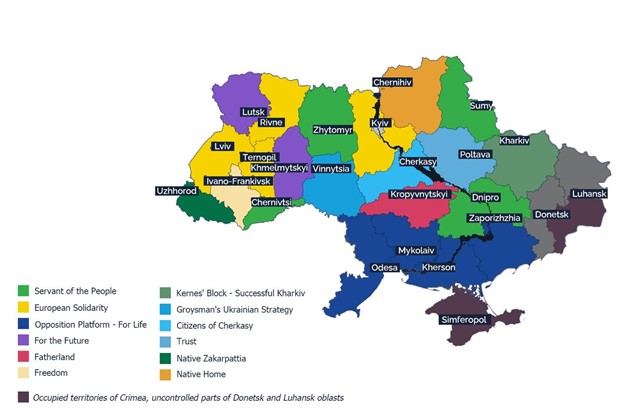Abstract
Territorial self-governance can take many forms, from federation, to federacy, to devolution. Provided the conditions are right, it can contribute to conflict prevention and settlement. Ukraine exhibits many characteristics in which the application of territorial self-governance could serve as a viable approach to managing the country’s diversity, many of these conditions are not met. This is nowhere more obvious than in relation to the re-integration of the self-declared people’s republics of Donetsk and Luhansk. Neither entity has legitimate and independent local elites, the Ukrainian state is institutionally too fragile to rise to the challenges of such a reintegration, and the current status quo, while volatile, satisfies the interests of various local, regional, and global stakeholders.
Introduction
Federation is a form of territorial organization that provides constitutional protection for powers independently exercised by second-tier entities within states. The exercise of such powers is subject only to the overall constitutional framework of the overall federal state. Such arrangements provide second-tier entities with their own individual legislative and executive competences, as well as with collective law-making powers, usually through the establishment of an upper chamber of the federal parliament that represents second-tier entities. This often also includes the ability to amend or block legislation passed by the lower chamber, especially where second-tier competences would be affected (Csergo et al. 2017, McGarry and O’Leary 2016, Weller and Wolff 2005).
Federations come in many different shades and are meant to serve a range of different purposes. One of these is to manage diversity. In such contexts, federal arrangements are best understood as a form of territorial self-governance that affords distinct groups an opportunity to have greater control over their own affairs and especially on matters that are important for the expression, preservation, and development of their particular identity.
The track record of federal arrangements, and other forms of territorial self-governance more generally, in managing diversity is far from spotless (McGarry and O’Leary 2009). However, there is an increasing body of evidence that self-governance arrangements contribute to lowering the risk of violent territory-centred conflict. They do so on their own, and even more so in combination with proportional electoral systems for the national legislature (Neudorfer et al. 2020).
However, federations and other territorial self-governance arrangements are not a panacea for managing the conflict potential of population diversity. They appear to be more effective if deployed preventively, rather than in response to an already violent escalation of a conflict (Cederman et al. 2015).
Not all drivers of conflicts arising from the challenges of diversity are equally ‘responsive’ to mitigation qua territorial self-governance. Hence, federal and other such arrangements work best as part of broader institutional packages in which they are combined, for example, with power-sharing and wealth-sharing mechanisms. Such broader packages can then ensure the effectiveness of conflict mitigation by addressing as comprehensively as possible all the drivers of a specific conflict (Wolff et al. 2020).
It is equally important that the process by which any institutional package and the territorial self-governance arrangements it includes are negotiated is inclusive of all relevant stakeholders. This minimises the risk of subsequent spoilers undermining any new institutional arrangement.
There will always be a residual risk of spoilers, but this can be managed, including by external stakeholders that can provide incentives and apply pressure as necessary to ensure the implementation of any negotiated deal and assist in its operation. For example, supporting domestic actors in negotiating, implementing, and operating a new system of territorial self-governance arrangements could include the provision of technical expertise and financial resources to give domestic actors the confidence to negotiate a workable deal that offers the right balance between local control and overall viable state structures. External support, moreover, can provide additional guarantees for negotiated arrangements to be honoured by all sides and it can ‘buy’ the time necessary for self-governance structures to bed down and deliver on the promises associated with them.
However, the very idea of devolving power from the centre to second-tier entities is often met with suspicion and resistance, raising the spectre of eventual disintegration of an existing state. This has, for example, been the case in Ukraine, where the concept of a federal arrangement has been discredited from the very first years of the country’s independence in 1991. Federation as a form of territorial state organisation has been anathema in the context of political competition among Ukrainian elites and in the more recent confrontation with Russia over Ukraine and Donbas.
Case-study
In contemporary Ukrainian political discourse ideas of federalism and federation are closely associated with separatism and secessionism, and thus with a threat to the sovereignty and territorial integrity of the Ukrainian state. However, the root causes of opposition to federalism in Ukraine go much deeper. In the period between 1991-2014, the rhetorical struggle over ideas and practices of territorial self-governance, and particularly federation, was part and parcel of the political competition between Kyiv and regionally-based politico-economic groups. Since the power base (both electoral support and the economic potential) of influential local elites were the industrially-developed, Russian speaking provinces of eastern Ukraine, demands for more local control may have been couched in terms of international best-practices of diversity management, but they also reflected an unsettled and fragile institutional environment in which different oligarchic networks competed for power and influence. Their opportunistic use of the language of diversity management manifested itself in an emphasis on cultural difference and laid them open to accusations of a pro-Russian and separatist agenda, cementing manageable differences into increasingly entrenched divides (Kuzio, 2015; Malyarenko and Wolff, 2019).
The pattern of gradual escalation in centre-periphery relations came to a head in 2013/4. The Euromaidan revolution in Kyiv triggered a new dynamic of domestic and external factors that led to the Russian annexation of Crimea and war between Ukraine and Russian-backed separatists in Donbas. This fundamentally altered the balance of power between centre and periphery and with it the feasibility and potential viability of any reform of subnational governance structures, all but ruling out any prospects of federalisation in Ukraine.
First, the power base of formerly regionally-based politico-economic groups decreased with the loss of their electorate in Donbas and Crimea. Now, any Ukrainian oligarch needs to cooperate with Kyiv to maintain economic and political power even locally. The best illustration of this is Rinat Akhmetov, who raised his wealth during the presidency of Leonid Kuchma (1991-2004) and strengthened it during that of Viktor Yanukovych (2010-2014). Yet, Akhmetov also managed to survive and consolidate what was left of his power during the presidency of Petro Poroshenko (2014-2019) and Volodymyr Zelenskiy (since 2019). Akhmetov started as one of the leaders of a Donetsk-based politico-economic group, the so-called ‘Donetskiye’. Before 2014, his major industrial assets were located in the Donbas region. He lost a significant part of his assets due to the occupation of Donetsk and Luhansk by Russian proxies and the subsequent establishment of the self-declared Donetsk People’s Republic and Luhansk People’s Republic. However, during the presidency of Petro Poroshenko, Akhmetov rebuilt and enlarged his business empire in other Ukrainian regions that remained under government control. Having mobilized employees of his enterprises in the defence of Mariupol in spring 2014, Akhmetov’s re-emergence as a national oligarch also benefitted from the support of government and parliament that granted his corporations privileges related to taxation, tariffs, and tenders. For example, the so-called ‘Rotterdam Plus’ deal negotiated by Poroshenko facilitated the rise of state-controlled prices for coal, supplied from coal-mining enterprises of DTEK, owned by Rinat Akhmetov, in exchange for DTEK’s Eurobonds, granted to Poroshenko’s company (see Malyarenko and Wolff, 2019; Hromadske International, 2020)
Second, the power base of local elites has fragmented and weakened. Before 2014, Ukrainian regional elites built the borders of their fiefdoms around 2-3 oblasts. The decentralization reform, started in 2014, facilitates the splitting up of these fiefdoms, which are now built around the cities and united territorial communities. This makes the territorial size of fiefdoms smaller and thus also proliferates the number of regional elites while decreasing the resource base upon which they can draw in furthering any broader agendas (Malyarenko and Wolff, 2020). The fragmentation of the power base of regional elites is taking place in the context of a further and progressive weakening of the Ukrainian state. This fragmentation process is obvious when one considers the outcomes of the local elections in 2020. As visually illustrated by the map below, locally-focused electoral initiatives, such as Kemes’ Bloc—Successful Kharkiv, Citizens of Cherkasy, or Native Zakarpattia, out-performed national parties like Servant of the People and European Solidarity in several local council election (see image below).
 Source: Карта результатов местных выборов в Украине 25.10.2020, https://en.wikipedia.org/w/
Source: Карта результатов местных выборов в Украине 25.10.2020, https://en.wikipedia.org/w/
Two important consequences of the shift in the centre-periphery relations in Ukraine are evident. First, the erosion of the power of regionally based politico-economic groups crucially weakened their position in competition with the centre. As the local elections of 2020 demonstrated, local power brokers failed to unite into a single political party that would have the capacity to challenge the power of the centre (Atlantic Council, 2020). This may structurally consolidate a more centralised and unitary state, but one that will lack effective executive capacity.
Second, the weakening of the positions of Ukrainian national oligarchs together with Russia’s decreasing leverage in Ukraine has opened the doors to increasing influence for global (US- and China-led) corporations (Malyarenko and Wolff 2021). Together, these processes further increase the institutional fragility of the Ukrainian state, which is further exacerbated by an increasing dependence of Ukraine on agriculture, resource extraction, remittances from labour migrants.
Thus, despite the ethnic, social, cultural, and economic diversity of Ukraine’s oblasts (the country’s effective second-tier entities), any changes towards meaningful federal or other territorial self-governance arrangements are hardly possible because of the lack of elites with the capacity to negotiate, implement, and operate them successfully. In addition, there is also a notable lack of public support for such reforms, given that they are associated with both self-serving oligarchic networks and an allegedly separatist, pro-Russian agenda. Only 11.1% of the Ukrainian population support federalization, while more than two-thirds (68.1%) are opposed to it (Razumkov Centre, 2020).
Special Status
While a federal arrangement is thus off the table for the foreseeable future, a special status within Ukraine has been discussed as a possible way to resolve the conflict in Donbas in the framework of the Minsk Agreements with the aim of peacefully reintegrating the self-declared people’s republics into Ukraine. Such proposals rest on the assumption that territorial self-governance arrangements, such as a federacy, can accommodate the needs and interests of local communities and elites in Donbas while preserving overall functioning state structures, thus reducing the potential for conflict between Kyiv and Donetsk/Luhansk.
Such arrangements would potentially have been an effective tool of conflict prevention in early 2014, when powerful and legitimate local elites in Donetsk and Luhansk voiced their disagreement with the results of the Euromaidan revolution. Now, after more than half a decade of violent conflict, the feasibility and viability of any special status arrangements as a way to restore Ukrainian sovereignty and territorial integrity in relation to the self-declared people’s republics, let alone Crimea, is more than doubtful.
The obstacles to such an approach to conflict settlement are formidable. First, Kyiv denies the leaders of DPR/LPR recognition as a party to the conflict, insisting, instead, on direct negotiations with Moscow (Semenova, 2019). Second, the Ukrainian government is fully aware of the progressive weakening of the Ukrainian state and the fact that reintegration of Donbas would further exacerbate its fragility (Ukrainian Pravda, 2020). Third, due to Russia’s strategy of societal destabilization in the self-declared people’s republics, there are no internally legitimate elites who have sufficient authority to negotiate a special status arrangement acceptable in Donetsk and Luhansk, Kyiv, Moscow, Brussels, and Washington (Malyarenko and Wolff, 2018).
Moreover, local elites in the DPR and LPR have very little agency of their own. While frequently seen as de-facto states similar to other such entities in the post-Soviet space like Abkhazia and South Ossetia in Georgia and Transnistria in Moldova, the actual situation in the two self-declared people’s republics resembles more that of a Russian occupation by proxy (Malyarenko and Wolff, 2019). Reintegration of both territories under special-status arrangements would, in all likelihood, immediately establish direct Russian leverage over Ukraine’s foreign and domestic policy and therefore pose unacceptable risks to Ukraine’s sovereignty and political stability.
Conclusions
It would be wishful thinking, therefore, to assume that territorial self-governance, whether in the form of federation or a federacy arrangement, can currently serve as a viable approach to managing Ukraine’s diversity challenges, and especially not in relation to the re-integration of the self-declared people’s republics of Donetsk and Luhansk. Not only are legitimate and independent local elites missing in Donetsk and Luhansk, but the Ukrainian state as a whole is also too weak at present to rise to the challenges of reintegration. With the conditions for viable territorial self-governance arrangements to function as effective conflict settlement mechanism absent, the task for Ukraine and its international partners is to make the current status quo viable and to work towards conditions under which reintegration within a meaningful system of territorial self-governance will be a realistic option.
Malyarenko, T and Wolff, S. 2021. ‘Territorial Self-governance and Separatism: The Case of (Eastern) Ukraine’, 50 Shades of Federalism. http://50shadesoffederalism.com/case-studies/territorial-self-governance-and-separatism-the-case-of-eastern-ukraine/.
Bibliography
Aslund, Anders. 2020. Ukrainian local elections: Zelenskyy fairytale is over. Atlantic Council. 25 October 2020. https://www.atlanticcouncil.org/blogs/ukrainealert/ukrainian-local-elections-zelenskyy-fairytale-is-over/.
Cederman, Lars-Erik, Simon Hug, Andreas Schädel, and Julian Wucherpfennig. 2015. Territorial Autonomy in the Shadow of Conflict: Too Little, Too Late. American Political Science Review 109 (02): 354–70. https://doi.org/10.1017/S0003055415000118.
Csergo, Zsuzsa, Philippe Roseberry, and Stefan Wolff. 2017. Institutional Outcomes of Territorial Contestation: Lessons from Post-Communist Europe, 1989-2012. Publius 47 (4): 491–521. https://doi.org/10.1093/publius/pjx025.
Hromadske International. 2020. EU to Join Investigation of Abuse on the Part of Akhmetov’s DTEK. Hromadske International. 4 March 2020. https://en.hromadske.ua/posts/eu-to-join-investigation-of-abuse-on-the-part-of-akhmetovs-dtek.
Kuzio, Taras. 2015. Rise and Fall of the Party of Regions Political Machine. Problems of Post-Communism 62(3): 174-186. https://doi.org/10.1080/10758216.2015.1020127.
Malyarenko, Tetyana and Stefan Wolff. 2021. Pawns, Partners, and ‘Smart Leadership’: Ukraine’s Opportunities in the China-Russia-West Triangle. PONARS Eurasia. Policy Memo No. 700. May 2021. https://www.ponarseurasia.org/wp-content/uploads/2021/05/Pepm700_Malyarenko-Wolff_May2021-1.pdf.
Malyarenko, Tetyana and Stefan Wolff. 2019. The Dynamics of Emerging De-Facto States: Eastern Ukraine in the Post-Soviet Space. London: Routledge. https://doi.org/10.4324/9780429448409.
Malyarenko, Tetyana and Stefan Wolff. 2018. The Logic of Competitive Influence-Seeking: Russia, Ukraine and the Conflict in Donbas. Post-Soviet Affairs, 34(4): 191-212. https://doi.org/10.1080/1060586X.2018.1425083.
McGarry, John, and Brendan O’Leary. 2016. Territorial Approaches to Ethnic Conflict Settlement. In The Routledge Handbook of Ethnic Conflict. Edited by Karl Cordell and Stefan Wolff. Second edition. London: Routledge, 258–73. https://doi.org/10.4324/9781315720425-31.
McGarry, John, and Brendan O’Leary. 2009. Must Pluri-National Federations Fail? Ethnopolitics 8 (1): 5–25. https://doi.org/10.1080/17449050902738838.
Neudorfer, Natascha S., Ulrike G. Theuerkauf, and Stefan Wolff. 2020. Territorial Self-Governance and Proportional Representation: Reducing the Risk of Territory-Centred Intrastate Violence. Territory, Politics, Governance. Online First. https://doi.org/10.1080/21622671.2020.1773920.
Semenova, Inna. 2019. ‘Ви нам винні – платіть.’ Пристайко про Росію, зустріч Путіна та Зеленського і вихід з мінських угод — головне з інтерв’ю BBC. Novoe Vremya. 14 November 2019. https://nv.ua/ukr/ukraine/politics/vadim-pristayko-rosiya-putin-i-zelenskiy-novini-ukrajini-50053487.html.
Razumkov Centre. 2020. Громадська думка про ситуацію на Донбасі та шляхи відновлення суверенітету України над окупованими територіями. Kyiv: Razumkov Centre. https://razumkov.org.ua/napriamky/sotsiologichni-doslidzhennia/gromadska-dumka-pro-sytuatsiiu-na-donbasi-ta-shliakhy-vidnovlennia-suverenitetu-ukrainy-nad-okupovanymy-terytoriiamy-liutyi-2020r.
Ukrainian Pravda. 2020. Безопасная реинтеграция ОРДЛО в Украину займет не менее 25 лет – Резников. Ukrainian Pravda. 10 November 2020. https://www.pravda.com.ua/rus/news/2020/11/10/7273060/.
Wolff, Stefan, and Marc Weller. 2005. Self-Determination and Autonomy: A Conceptual Introduction. In Autonomy, Self Governance and Conflict Resolution: Innovative Approaches to Institutional Design in Divided Societies. Edited by Marc Weller and Stefan Wolff. London: Routlegde, 1-25. https://doi.org/10.4324/9780203461914.
Wolff, Stefan, Simona Ross, and Asbjorn Wee. 2020. Subnational Governance and Conflict: The Merits of Subnational Governance as a Catalyst for Peace. Washington, D.C.: World Bank. https://doi.org/10.1596/34436.
Further Reading
Malyarenko, Tetyana and Stefan Wolff. 2019. The Dynamics of Emerging De-Facto States: Eastern Ukraine in the Post-Soviet Space. London: Routledge. https://doi.org/10.4324/9780429448409.
McGarry, John, and Brendan O’Leary. 2016. Territorial Approaches to Ethnic Conflict Settlement. In The Routledge Handbook of Ethnic Conflict. Edited by Karl Cordell and Stefan Wolff. Second edition. London: Routledge, 258–73. https://doi.org/10.4324/9781315720425-31.
Wolff, Stefan, Simona Ross, and Asbjorn Wee. 2020. Subnational Governance and Conflict: The Merits of Subnational Governance as a Catalyst for Peace. Washington, D.C.: World Bank. https://doi.org/10.1596/34436.


